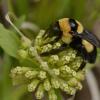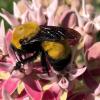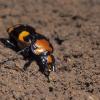
The Diana fritillary is a large and beautiful butterfly, and much sought after by collectors. The core of the distribution is in the southern Appalachians from central Virginia and West Virginia through the mountains to northern Georgia and Alabama. It is also found west of this in the Ozark Mountains of Missouri, Arkansas, and eastern Oklahoma. Although the Diana fritillary is widespread, its populations are scattered within that range and fluctuate greatly between years. As a forest-dependent species, threats to the Diana fritillary come mainly from forest management: logging operations and pest control. Another significant threat is strip mining.
Taxonomic Status
(Lepidoptera: Nymphalidae: Argynninae)
Speyeria diana (Cramer), 1775. It is often referred to as simply the Diana.
The Diana fritillary is a large and beautiful butterfly, and much sought after by collectors. It is in the family Nymphalidae (brush-foots). Its wingspan is 3 ⁷⁄₁₆ to 4 ⁷⁄₁₆ inches (8.7 to 11.3 cm).
Male and female butterflies differ. The uppersides of male wings are black in the basal half and orange with black veins and small spots in the outer half. Females are black with white spots in the outer half of the forewing and with blue spots on the outer part of the hindwing. (They mimic the Pipevine Swallowtail.) The undersides of the wings are dark greenish brown, without spots.
There is one flight from June to September. Males emerge before females and patrol within the forest. Females lay eggs later in the flight period, mainly August, walking along the ground and attaching eggs singly to twigs and dead leaves. As with other Speyeria species, the caterpillars hatch and hibernate without feeding. They emerge in spring to feed on the leaves and flowers of various species of violets.
Adults feed on nectar from a variety of plants, including milkweeds (Asclepias sp.), ironweed (Vernonia sp.), and red clover (Trifolium pratense). Males will also drink fluids from dung.
The core of the distribution is in the southern Appalachians from central Virginia and West Virginia through the mountains to northern Georgia and Alabama. It is also found west of this in the Ozark Mountains of Missouri, Arkansas, and eastern Oklahoma.
Habitats for the Diana fritillary are the edges and openings in moist, rich mountain forests. They will also use pastures, shrublands, and fields for nectaring but will only breed if there is a suitable forest margin. Larval hostplants are various species of violets (Viola sp.)
Xerces Red List Status: Vulnerable
Other Rankings:
Canada – Species at Risk Act: N/A
Canada – provincial status: N/A
Mexico: N/A
USA – Endangered Species Act: None
USA – state status: None
NatureServe: G3
IUCN Red List: N/A
Although the Diana fritillary is widespread, its populations are scattered within that range and fluctuate greatly between years. It appears most secure in the southern Appalachians and Arkansas-Missouri, but threats are present range-wide.
It is known to be susceptible to habitat change. Historically, it was more widespread and likely more abundant within its range. Land clearance in the nineteenth and twentieth centuries reduced the overall range and virtually eradicated the Diana fritillary from the Ohio Valley, eastern Virginia, and eastern North Carolina. Records for Indiana, Maryland, Ohio, and Pennsylania are almost all from the nineteenth century or earlier.
As a forest-dependent species, threats to the Diana Fritillary come mainly from forest management: logging operations and pest control. Of these, pest control is likely the bigger long term-threat. The Diana fritillary can recolonize cut areas once the forest grows back. Spraying for pests, especially gypsy moth, can significantly reduce larval populations. (Third instar larvae showed particular sensitivity to Btk.) A lack of survey information identifying the location of major Diana populations makes it harder for forest managers to plan spray operations to minimize impacts.
Another significant threat is strip mining, which destroys the habitat. Other concerns include the spread of invasive garlic mustard and the growth in deer populations; both could reduce the abundance of hostplant violets if allowed to get out of control.
Forest habitat for this butterfly should be protected from unnecessary logging and should not be sprayed.
Surveys to located populations should be done and the information included in forest planning processes. Long-term population monitoring should be done to evaluate the impacts of logging and spraying and to assess the ability to recolonize disturbed areas.
Opler, P. A., and G. O. Krizek. 1984. Butterflies East of the Great Plains. Johns Hopkins University Press, Baltimore, MD.
Opler, P. A., and V. Malikul. 1992. A Field Guide to Eastern Butterflies. Peterson Field Guide #4. Houghton-Mifflin Co., Boston, MA.
Scott, J. A. 1986. The Butterflies of North America. Stanford University Press, Stanford, CA.
Profile prepared by Mace Vaughan and Matthew Shepherd, The Xerces Society for Invertebrate Conservation.
Citation
Vaughan, D. M., and M. D. Shepherd. 2005. Species Profile: Speyeria diana. In Shepherd, M. D., D. M. Vaughan, and S. H. Black (Eds). Red List of Pollinator Insects of North America. CD-ROM Version 1 (May 2005). Portland, OR: The Xerces Society for Invertebrate Conservation.





